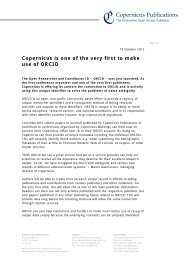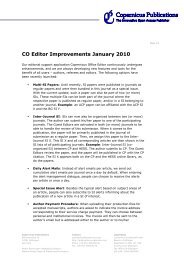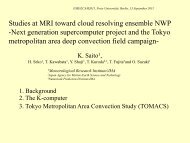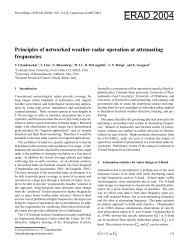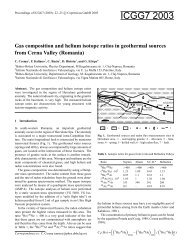ERAD 2002
ERAD 2002
ERAD 2002
You also want an ePaper? Increase the reach of your titles
YUMPU automatically turns print PDFs into web optimized ePapers that Google loves.
K. Friedrich and M. Hagen: Vector fields using a bistatic Doppler radar 207<br />
= C A H A ? D B A @<br />
4 E A @<br />
E ? D J A = K<br />
<br />
+ 0 - <br />
> A H F B = B B A D B A <br />
<br />
! <br />
, K = , F F A H<br />
6 H E F A , F F A H<br />
" , F F A H<br />
Fig. 1. Map of the bistatic multiple-Doppler radar network at the<br />
DLR in OP consisting of POLDIRAD and three bistatic receivers<br />
located at Lichtenau, Lagerlechfeld, and Ried. The investigation<br />
area is restricted by the horizontal antenna aperture of the bistatic<br />
antennas. The equation system to calculated the horizontal wind–<br />
field is exactly determined in the dual-Doppler areas (hatched) and<br />
overdetermined in the triple- or quadruple–Doppler areas (crosshatched).<br />
More explanations in the text.<br />
tal wind–vector field directly. The vertical component, w, is<br />
retrieved by means of a variational analysis method (Protat<br />
and Zawadzki, 1999).<br />
3 The quality–control scheme<br />
" <br />
# <br />
3.1 The decision criterion based on the signal quality<br />
At the remote receiver the velocity–power spectrum is obtained.<br />
The power, Doppler velocity, and normalized coherent<br />
power 1 (NCP) are transfered to the central hub computer<br />
located at OP, where the data of all receivers is collected, the<br />
horizontal wind–field is determined and quality–controlled.<br />
At the central bistatic hub computer, first data with large<br />
velocity dispersion and low reflectivity factors are rejected<br />
using an empirically chosen threshold of NCP ≤ 0.3.<br />
As an example of applying the NCP criterion on measured<br />
data, Fig. 2 presents a horizontal cross–section at 1.6 km<br />
above MSL of the horizontal wind–vector field superimposed<br />
on the bistatic reflectivity factor, Zb, measured by the bistatic<br />
receiver Lagerlechfeld. In Figure 2a the NCP criterion is not<br />
applied, while in Fig. 2b noisy data is removed using the NCP<br />
criterion.<br />
3.2 The quality–index fields<br />
The following algorithms are applied in the fuzzy logic sense<br />
weighting the quality with values ranging from zero to one.<br />
The results of each weighting algorithm can be merged to<br />
1 Index related inversely to the spectral width ranging from zero<br />
to one (for more details see (Friedrich, <strong>2002</strong>)).<br />
Zb[dBZ] (a) Zb[dBZ] (b)<br />
Fig. 2. Horizontal cross–section at 1.6 km above MSL of the horizontal<br />
wind in m s −1 (arrows) underlaid by the bistatic reflectivity<br />
factor field, Zb, in dBZ measured by the receiver Lagerlechfeld on<br />
2 February 2000 at 17:08 UTC (a) without applying the NCP criterion<br />
and (b) with applying the NCP criterion on the measured data.<br />
The horizontal wind–vector is determined by using the Doppler velocity<br />
sampled by receivers Lagerlechfeld and OP.<br />
achieve an average quality–control field which reflects the<br />
confidence of each horizontal wind measurement. All thresholds<br />
are set empirically.<br />
In the following sections, three quality–index fields are defined<br />
according to: (1) the accuracy of the horizontal wind–<br />
field depending on the location of transmitter, target, and<br />
); (2) the probability of side-<br />
receiver, denoted as F (σ ′ |Vh|<br />
lobe contamination, denoted as F (∇Z); and (3) the fractional<br />
uncertainty of the wind–field measurement, denoted<br />
as F (σ ′ |Vh| /|Vh|). Note that the standard deviation of the<br />
horizontal wind–field, induced by the position of transmitter,<br />
target, and receivers, is fixed for a chosen experimental<br />
setup.<br />
The influence of each quality–index field on the average<br />
quality–index field can be chosen according to<br />
the application of those quality–controlled wind–vectors<br />
and the weather situation with the respective weights<br />
W F (σ ′<br />
|V h | ), W F (∇Z), and W F (σ ′<br />
|V h | /|Vh|). W F (vr/vt). The<br />
quality fields can then be averaged to a single quality field<br />
using<br />
¯F = 1<br />
<br />
C<br />
where<br />
W F (σ ′ |Vh |)F (σ ′ |Vh|) + W F (∇Z)F (∇Z) +<br />
W F (σ ′<br />
|V h | /|Vh|)F (σ ′ |Vh| /|Vh|)<br />
C = W F (σ ′ |Vh |) + W F (∇Z) + W F (σ ′<br />
|V h | /|Vh|)<br />
<br />
, (1)<br />
Each quality–index field and the average index field range<br />
between zero and one.<br />
3.2.1 Utilizing geometrical accuracy<br />
The horizontal wind–field is determined by the velocity components<br />
measured by the monostatic and bistatic receiver.<br />
.




